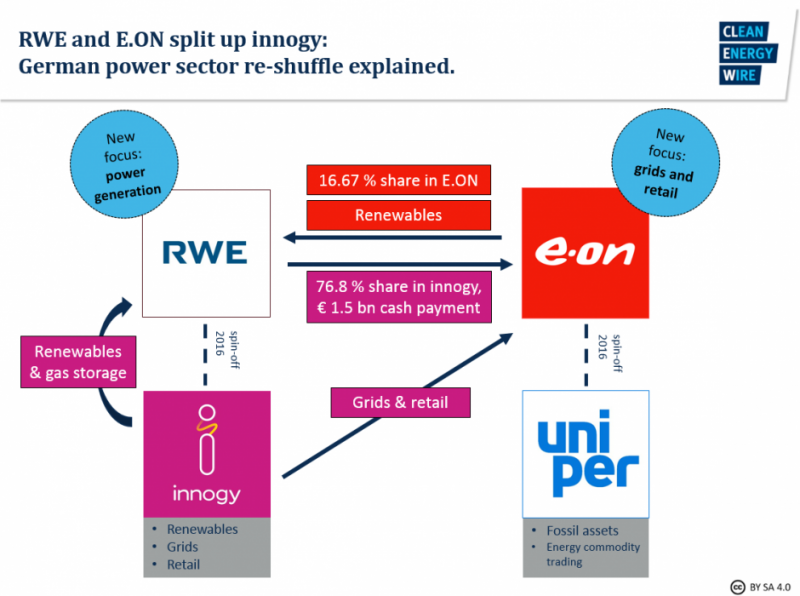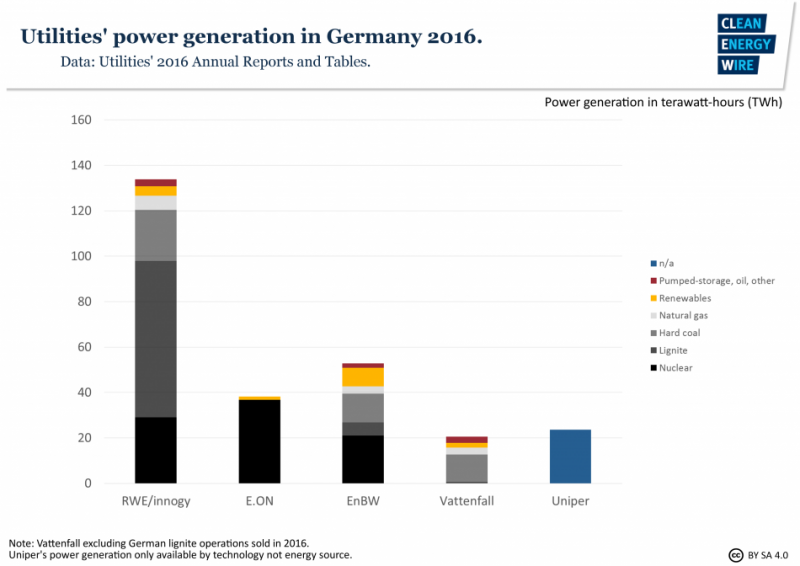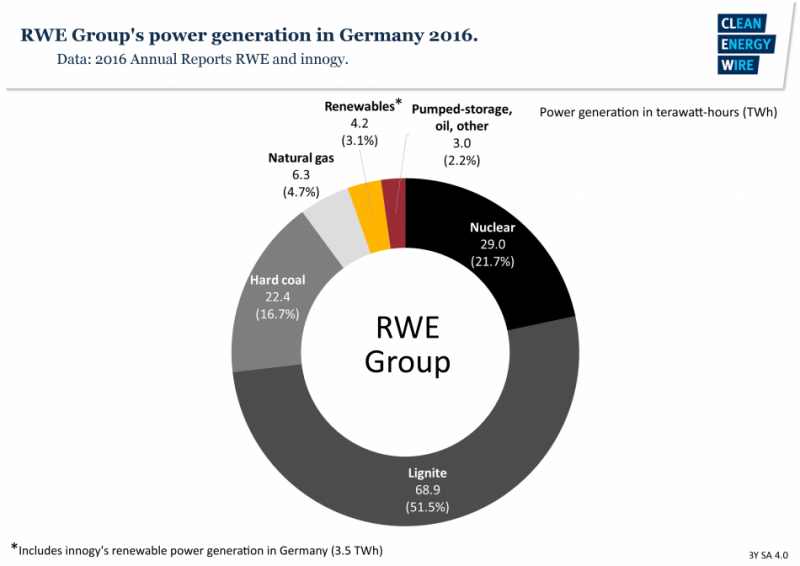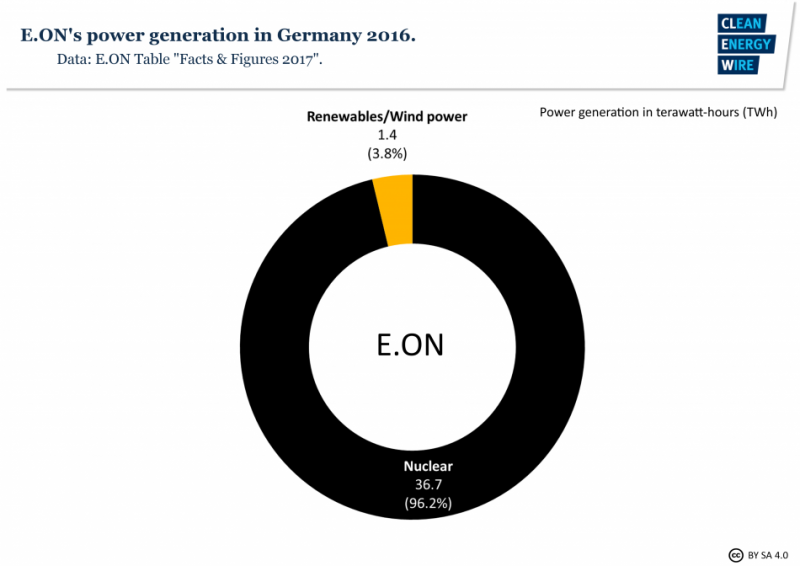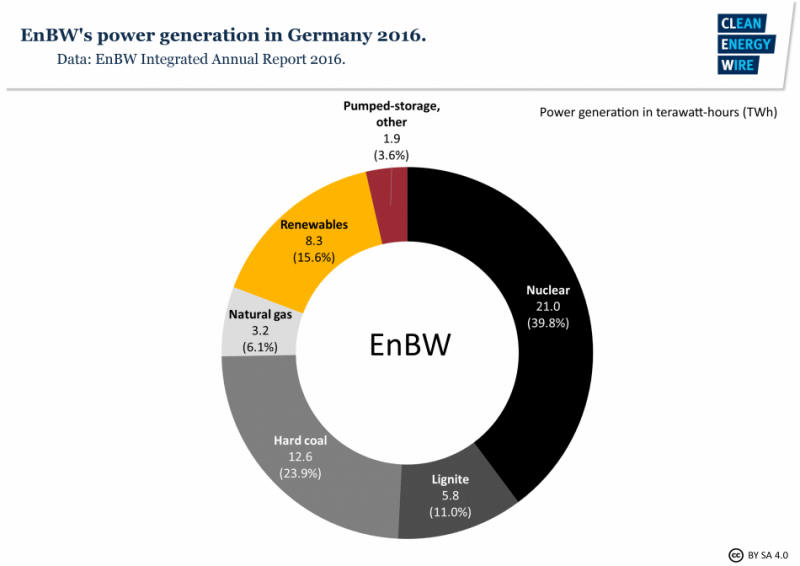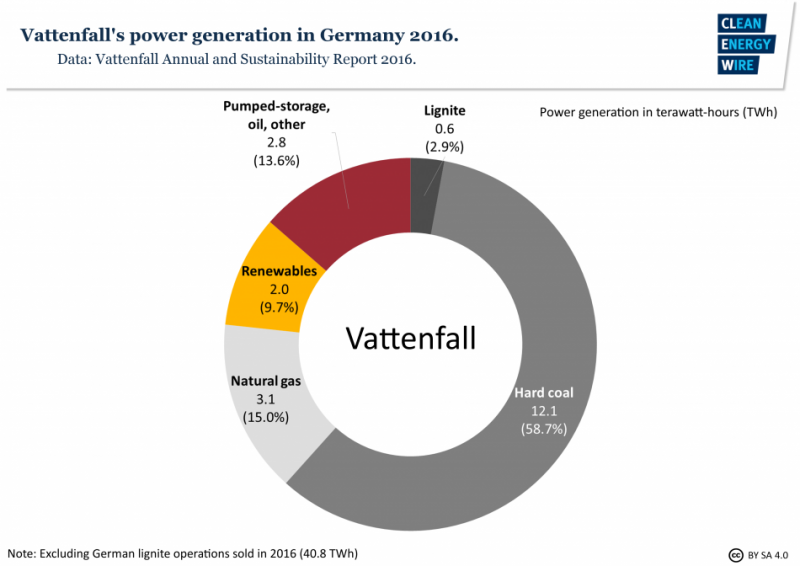Germany’s largest utilities at a glance
RWE and E.ON overhaul power sector with innogy split
RWE and E.ON agreed in March 2018 to a major asset-swapping deal that would drastically reshape Germany's energy landscape, already in turmoil as the country's phase-out of nuclear power and transition to renewable power sources is wrecking old business models, and new competitors enter the frame. E.ON plans to buy RWE's green power subsidiary innogy, and the two utilities will exchange large parts of their assets to focus their activities. E.ON is to concentrate on the highly regulated distribution grid with its stable returns and end-customer focused energy solutions, while RWE takes on E.ON's and innogy's renewable businesses, on top of coal- and gas-fired power plants. The following graph illustrates major components of the complex deal:
Find a collection of reactions to the deal from German politicians, energy companies and researchers here.
Check the CLEW dossier Utilities and the energy transition for background on Germany's changing energy market.
Please note: The remainder of this factsheet has not been updated and is based on data available in May 2017.
RWE Group
Key figures 2016
Revenue: 45.8 billion euros (-5% vs 2015)
- thereof 40 billion euros attributable to innogy
Adjusted EBIT: 3.1 billion euros (-20%)
Net loss: 5.7 billion euros (2015 loss: 170 million euros)
Employees: 58,652, thereof 40,636 at innogy
Market capitalization: 9.3 billion euros (May 2017)
Power generation: 216.1 TWh, thereof 133.8 TWh in Germany
[Sources: Annual Report 2016, Tables from Annual Report 2016]
RWE is headquartered in the city of Essen and focuses on conventional power generation and energy trading, after the carve-out of its renewables, grid and retail operations created subsidiary innogy SE in April 2016. RWE still owns almost 77 percent of innogy’s shares, which is therefore included in its financial results. RWE’s most important markets are Germany, the Netherlands, the UK, and Turkey.
RWE’s net loss in 2016 amounted to 5.7 billion euros, mostly due to a 4.3 billion euros impairment on German power plants and other assets in Europe. Furthermore, RWE had to increase nuclear energy provisions for risk surcharges and is expected to contribute 6.8 billion euros to Germany’s state-administered fund for nuclear clean-up and final storage of radioactive waste.
According to British climate NGO Sandbag, RWE operates three of Europe’s five most polluting lignite power plants, and the associated lignite mines. In 2016, RWE’s fossil power plants generated 130 terawatt hours of electricity in Germany, compared to innogy’s less than four terawatt hours from renewables.
Towns and cities in RWE’s home region own around 13 percent of RWE. This pool is RWE’s largest individual shareholder, and therefore exerts strong influence on the company’s decision-making. Company CEO is Rolf Martin Schmitz, who was Chief Operating Officer (COO) of the “old” RWE.
innogy
Key figures 2016
Revenue: 43.6 billion euros (- 4% vs 2015)
- thereof Retail in Germany: 16.5 billion euros
Grid & Infrastructure in Germany: 9.8 billion euros
Renewables: 0.8 billion euros
Adjusted EBIT: 2.7 billion euros (-10%)
Net income: 1.5 billion euros (-6%)
Market capitalization: 18.8 billion euros (May 2017)
Customers: 23 million customers in Europe, including the grid and retail segments. Total electricity customers 16.1 million, thereof 6.8 million in Germany.
Employees: 40,636, thereof 20,083 in Germany
Power generation: 10.8 TWh, thereof 3.5 TWh in Germany
[Sources: Annual Report 2016, Tables from Annual Report 2016]
RWE’s renewables spin-off innogy is Germany’s largest power provider with 6.8 million customers, and also the country’s dominant distribution grid operator. Active in 16 countries across Europe, innogy employs about half of its 41,000 employees in Germany and, like RWE, is based in Essen.
Innogy pools RWE’s renewables, grid and infrastructure and retail businesses. In one of Germany’s largest initial public offerings, innogy had its stock market debut in October 2016. RWE owns about 77 percent of innogy’s shares.
In May 2017, innogy had a market capitalization of almost 19 billion euros, making it about twice as valuable as its parent company RWE – and furthermore the most valuable German utility. Innogy does not operate nuclear or conventional power plants. In contrast to other German utilities, innogy recorded a positive net income of 1.5 billion euros. Only E.ON’s fossil spin-off Uniper also managed to get into the black in 2016 (see below).
At 3.5 terawatt hours, innogy’s renewable power generation in Germany in 2016 – mostly wind and hydro power – equals about three percent of RWE’s German fossil-based power output (see above).
The company is headed by Peter Terium, formerly CEO of the “old” RWE.
E.ON
Key figures 2016
Sales: 38.2 billion euros (-10.5% vs 2015)
- thereof Energy networks in Germany: 13.2 billion euros
Customer solutions in Germany: 7.8 billion euros
Renewables: 1.4 billion euros
Adjusted EBIT: 3.1 billion euros (-13%)
Net loss: 16 billion euros (2015 loss: 6.4 billion euros)
Market capitalization: 16.2 billion euros (May 2017)
Customers: 5.3 million power customers in Germany, out of a total 22.3 million power and gas customers
Employees: 43,138, thereof 17,239 in Germany
Power generation: 48.3 TWh, thereof 38.1 TWh in Germany
[Sources: Annual Report 2016, Table “Facts & Figures 2017”]
As Germany’s second largest power provider, E.ON supplies electricity to 5.3 million customers in the country and operates 349,000 km, or 19 percent, of the German power distribution network. At the start of 2016, E.ON split into two companies, transferring its fossil power generation and global energy trading business into the newly formed Uniper. E.ON remains Uniper’s largest shareholder with a stake of nearly 47 percent, but plans to reduce its share.
Under the leadership of CEO Johannes Teyssen, who was also the head of the “old” E.ON, the company now focuses on renewables, grids and customer solutions. A new law on nuclear liabilities forced E.ON to keep its German nuclear power operations – renamed Preussen Elektra – while transferring its hydropower/pump-storage assets to Uniper. As a result, E.ON’s German power generation portfolio is heavily dominated by nuclear, which accounted for 96 percent in 2016, while renewables – only relying on wind power – made up 4 percent (See “Facts & Figures Renewables and Preussen Elektra”).
E.ON incurred a record net loss of 16 billion euros in 2016 and announced to cut 1,300 jobs, triggered partly by significant impairments on fossil power plants now belonging to Uniper.
Uniper
Key figures 2016
Sales: 67.3 billion euros (-27% vs 2015)
Adjusted EBIT: 1.4 billion euros (+70%)
Net income: 210 million euros
Market capitalization: 6 billion euros (May 2017)
Customers: in Germany mostly municipal utilities and industry
Employees: 12,635, thereof 4,498 in Germany
Power generation: 149.2 TWh, thereof 23.6 TWh in Germany
[Sources: Annual Report 2016, Press release ]
Düsseldorf-based Uniper has about 13,000 employees and is E.ON’s fossil energy spin-off. It has taken over the “old” E.ON’s conventional generation and energy commodity trading business and launched as an independent company at the start of 2016. E.ON remains Uniper’s largest shareholder with a stake of about 47 percent.
In September 2016, Uniper was listed on the Frankfurt Stock Exchange and had a market capitalization of about six billion euros in May 2017. In its first year, Uniper’s profit was mainly driven by a strong gas business and new gas supply contracts with Russian Gazprom.
The company headed by CEO Klaus Schäfer generated close to 24 TWh of electricity in Germany in 2016, supplying mainly municipal utilities and industry.
EnBW
Key figures 2016
Revenue: 19.4 billion euros (-8.5% vs 2015)
- thereof Sales: 7.8 billion euros
Grids: 6.6 billion euros
Generation and Trading: 4.4 billion euros
Renewables: 0.5 billion euros
Adjusted EBIT: 1.0 billion euros (-13%)
Net loss: -1.7 billion euros (2015 income: 234 million euros)
Market capitalization: 6 billion euros (May 2017)
Customers: 5.5 million customers of electricity, gas, water and energy-related products and services
Employees: 20,409
Power generation: 52.8 TWh, all in Germany
[Sources: Integrated Annual Report 2016 and Excel sheet, Press release]
Like fellow nuclear plant operators – RWE, E.ON and Vattenfall – EnBW’s 2016 financial results were affected by expected payments for the nuclear clean-up, partly incorporated in 2016 financial statements. Along with low electricity prices, this resulted in a net loss of 1.8 billion euros to shareholders of EnBW AG. On July 1, 2017, EnBW is due to pay 4.7 billion euros into the state-administered fund to finance interim and final storage of nuclear waste as well as decommissioning and dismantling nuclear plants.
In 2013, EnBW announced its aim to double the share of renewable power generation capacity to over 40 percent by 2020 – currently at 23 percent (2016) – focusing on wind and hydro power. EnBW operates the transmission and large parts of the distribution grid (153,000 km) in Baden-Württemberg through its subsidiaries TransnetBW and Netze BW.
The state of Baden-Württemberg and Oberschwäbische Elektrizitätswerke, a consortium of municipal governments, together own over 93 percent of EnBW.
EnBW, which is headed by CEO Frank Mastiaux, was one of two companies committing to build offshore wind farms without support payments in Germany’s first auction for the technology.
Vattenfall
Key figures (Excluding lignite operations sold in 2016)
Net Sales: 14.7 billion euros (-3% vs 2015)
Underlying operating profit (adjusted EBIT): 2.3 billion euros (+6%)
Net loss: 233 million euros (including discontinued German lignite operations: loss of 5.2 billion euros)
Customers: 6.3 million electricity customers, thereof 3.5 in Germany
Employees: 19,935 (-30%) after sale of German lignite operations, thereof 6,998 (-53%) employees in Germany today
Power generation: 119.2 TWh, 20.6 TWh in Germany
[Sources: Annual Report 2016, Annual and Sustainability Report 2016, Vattenfall at a glance, Vattenfall operations in Germany]
Vattenfall, is owned by the Swedish state and among Germany’s top four electricity providers, supplying 3.5 million power customers. Vattenfall’s subsidiary Stromnetz Berlin owns and operates the capital’s electricity grid. The sale of its German lignite operations to Czech energy company EPH in 2016 halved the number of its employees in the country to about 7,000 people. Vattenfall had previously been operating five opencast lignite mines and four lignite-fired power stations in East German Lusatia.
Vattenfall's former East German lignite plants are now operated by LEAG, which is owned by EPH and PPF Investments and generated 54.9 terawatt hours of electricity last year.
Vattenfall no longer operates nuclear power stations in Germany.

